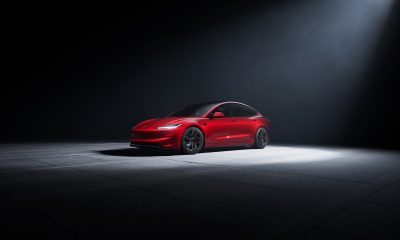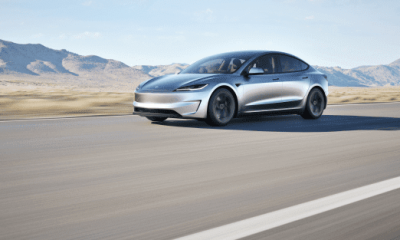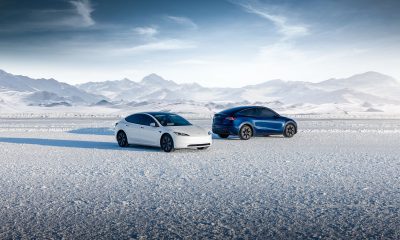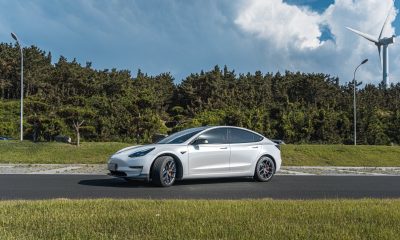
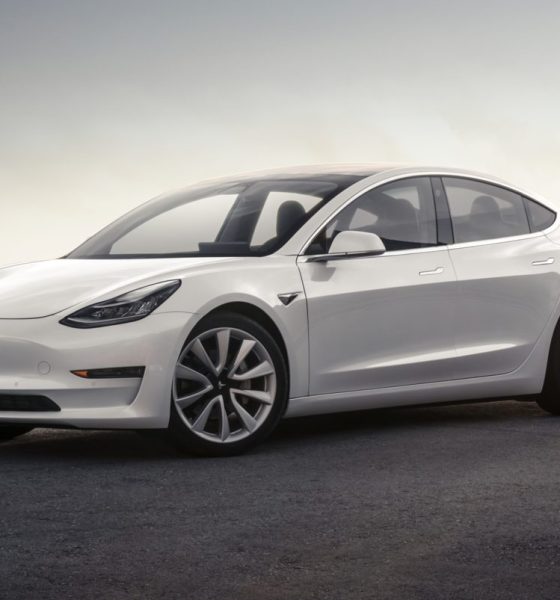
News
Tesla Model 3 specs: 220-mile standard with 310-mile option for $9k
It’s finally official: the Tesla Model 3 will feature two battery options, one with 220 miles of range and a second with 310 miles of range.
While Tesla CEO Elon Musk did not go into details of the battery pack sizing, it is presumed that the standard offering will utilize an approximately 50 kWh pack size – down from the expected 60 kWh battery – and 75 kWh battery for its long range offering. Performance between the two offerings and their respective pricing were outlined by the California-based electric car company via their presskit.
As previously speculated, the Model 3 will be offered — before state and federal incentives — at $35,000 with the standard range option and $44,000 if upgraded to the long-range option. As the newly affordable EV from Tesla, the Model 3 has taken its first step to cementing itself as the game changing electric car with the best technology, customer value and, internally, a vehicle that delivers high profit margins.
The battery range and power, and access to Tesla’s extensive Supercharger network could mean that the Model 3 will soon chip away at a market that’s been predominantly ruled by internal combustion engine (ICE) cars.
The announcement came as part of the Model 3 delivery event in Fremont, Calif. CEO Elon Musk told Tesla fans and future owners about the new battery and range options before handing over the first 30 Model 3s to their respective new owners. Musk stated that the company has produced 50 production cars this month, with the other 20 vehicles being used for validation testing.
With a design that is lightweight and sports an industry-leading drag coefficient, Tesla Model 3 could be among the most efficient vehicles on the road. The Model 3 will also be one of the lowest cost EVs, while sporting one of the highest ranges on the market. By comparison, the Chevy Bolt that starts at $36,620 tops out at 238-miles of range while the premium Model 3 will have a 310-mile per charge driving range.
We’ve provided the full details of the standard equipment, base Model 3 which begins at a starting price of $35,000.
STANDARD EQUIPMENT
Price – $35,000
Standard Battery
- Range: 220 miles (EPA estimated)
- Supercharging rate: 130 miles of range per 30 minutes
- Home charging rate: 30 miles of range per hour (240V outlet, 32A)
- Deliveries begin: Fall 2017
Performance
- 0-60 mph: 5.6 seconds
- Top speed: 130 mph
Interior
- 15” touchscreen display
- Dual zone climate control system
- FM/Internet streaming radio
- Textile seating
- Front center console with open storage and two USB ports
Convenience
- Onboard maps and navigation
- Wi-Fi and LTE internet connectivity
- Keyless entry and remote climate control using the Tesla app
- Voice activated controls
- Bluetooth hands-free calling and media streaming
- 60/40 split folding rear seat to maximize cargo options
- Back-up camera
- Auto dimming rear-view mirror
- One-touch power windows throughout
- Power-adjustable side mirrors
- 12-volt power outlet
Safety
- Full LED exterior lighting
- Eight cameras, forward radar and twelve ultrasonic sensors enabling active safety technologies including collision avoidance and automatic emergency braking
- Six front row and two side curtain airbags
- Three-point safety belts with belt-reminders for driver and four passengers
- Two LATCH (Lower Anchors and Tethers for Children) attachments in second row
- Electronic stability and traction control
- Four-wheel antilock disc brakes with electronic parking brake
- Child safety locks
- Anti-theft alarm system
- Tire pressure monitoring system
Warranty
- Vehicle: 4 year, 50,000 mile limited warranty
- Battery warranty: 8 year, 100,000 mile (120,000 mile with Long Range Battery)
OPTIONS
Long Range Battery – $9,000
- Range: 310 miles
- Supercharging rate: 170 miles of range per 30 minutes
- Home charging rate: 37 miles of range per hour (240V outlet, 40A)
- 0-60 mph: 5.1 seconds
- Top speed: 140 mph
- Deliveries begin: July 2017
Paint
- Solid Black: Standard
- Midnight Silver Metallic: $1,000
- Deep Blue Metallic: $1,000
- Silver Metallic: $1,000
- Pearl White Multi-Coat: $1,000
- Red Multi-Coat: $1,000
Wheels
- 18” Aero: Standard
- 19” Sport: $1,500
Premium Upgrades Package – $5,000
Upgraded interior with additional features and premium materials.
- Premium heated seating and cabin materials throughout, including open pore wood décor and two rear USBs
- 12-way, power adjustable front seats, steering column and side mirrors, with custom driver profiles
- Premium audio system with more power, tweeters, surround speakers and subwoofer
- Tinted glass roof with ultraviolet and infrared protection
- Auto dimming, power folding, heated side mirrors
- LED fog lamps
- Center console with covered storage and docking for two smartphones
Enhanced Autopilot – $5,000
Model 3 will match speed to traffic conditions, keep within a lane, automatically change lanes, transition from one freeway to another, exit the freeway and self-park at your destination.
Additional features will roll out over time through software updates.
Full Self-Driving Capability – $3,000 (requires Enhanced Autopilot)
In the future, Model 3 will be capable of conducting trips with no action required by the person in the driver’s seat.
This feature is dependent upon extensive software validation and regulatory approval, which may vary by jurisdiction.
VEHICLE SPECIFICATIONS
Dimensions & Weight
- Length: 184.8”
- Width: 72.8” (76.1” with mirrors folded)
- Height: 56.8”
- Wheelbase: 113.2”
- Track (wheel center): 62.2” front and rear
- Ground clearance: 5.5”
- Head room, standard: 39.6” front row, 37.7” second row
- Head room, glass roof: 40.3” front row, 37.7” second row
- Leg room: 42.7” front row, 35.2” second row
- Shoulder room: 56.3” front row, 54.0” second row
- Hip room: 53.4” front row, 52.4” second row
- Seating capacity: 5 adults
- Luggage capacity: 15 cubic feet
- Curb weight:
- 3549 lbs. (Model 3)
- 3814 lbs. (Model 3 Long Range)
- Weight distribution:
- 47% front, 53% rear (Model 3)
- 48% front, 52% rear (Model 3 Long Range)
Body
- Hybrid steel/aluminum body
- Drag coefficient of 0.23
Chassis
- Double wishbone, virtual steer axis front suspension with coil over twin-tube shock absorbers and stabilizer bar
- Independent multi-link rear suspension with twin-tube shock absorbers and stabilizer bar
- Variable ratio, speed sensitive electronic power steering
- Electromechanically boosted four wheel anti-lock disc brakes with electronic brake force distribution
- 18” Aero or 19” Sport wheels with all-season tires
Standard Accessories
- 240 volt NEMA 14-50 adapter
- 120 volt NEMA 5-15 adapter
- J1772 public charging adapter
- 20 foot mobile connector with storage bag
Elon Musk
Tesla says texting and driving capability is coming ‘in a month or two’
“In the next month or two, we’re going to look at the safety statistics, but we’re going to allow you to text and drive, essentially.”

Tesla CEO Elon Musk said that within the next month or two, the company will be able to open the ability for people to text and drive because its Full Self-Driving suite will be robust enough to allow drivers to take their attention away from the road.
In its current state, Tesla Full Self-Driving is a supervised driver assistance suite that requires the vehicle operator to maintain control of the vehicle and pay attention to the road surroundings.
However, the company has been aiming to release a fully autonomous version of the Full Self-Driving suite for years, teasing its future potential and aiming to release a Level 5 suite as soon as possible.
CEO Elon Musk believes the company is on the cusp of something drastic, according to what he said at yesterday’s Annual Shareholder Meeting.
One thing Musk hinted at was that the company should be able to allow those sitting in the driver’s seat of their cars to text and drive “in the next month or two,” as long as the statistics look good.
He said:
“In the next month or two, we’re going to look at the safety statistics, but we’re going to allow you to text and drive, essentially.”
The company recently transitioned to its v14 Full Self-Driving suite, which is its most robust to date, and recently expanded to Cybertruck, completing its rollout across the vehicle lineup.
Currently, Tesla is running v14.1.5, and when major improvements are made, that second number will increase, meaning v14.2 will be the next substantial improvement.
Musk said that v14.3 will be when you can “pretty much fall asleep and wake up at your destination.”
🚨🚨 Elon Musk says Tesla Full Self-Driving v14.3 will be when you can “pretty much fall asleep and wake up at your destination.”
We are on v14.1 currently 👀 pic.twitter.com/KMkWh5Qa7T
— TESLARATI (@Teslarati) November 6, 2025
We’ve heard a considerable amount of similar statements in the past, and Tesla owners have been conditioned to take some of these timeframes with autonomous driving with a grain of salt.
However, with the upgrades in FSD over the past few months, especially with the rollout of Robotaxi in Austin, which does not utilize anyone in the driver’s seat for local roads, it does not seem as if autonomy is that far off for Tesla.
News
Tesla Semi undergoes major redesign as dedicated factory preps for deliveries
The Semi has been one of the most anticipated products in the Tesla lineup due to the disruption it could cause in the trucking industry.

Tesla put its all-electric Semi truck through quite a major redesign as its dedicated factory for the vehicle is preparing for initial deliveries to the public starting next year.
The Semi has been one of the most anticipated products in the Tesla lineup due to the disruption it could cause in the trucking industry.
It has already been in numerous pilot programs for some pretty large companies over the past couple of years, PepsiCo. being one of them, and it is moving toward first deliveries to other companies sometime in 2026.
Yesterday at the 2025 Annual Shareholder Meeting, Tesla unveiled its new Semi design, which underwent a pretty significant facelift to match the aesthetic and vibe of the other vehicles in the company’s lineup.
Additionally, Tesla announced some other improvements, including changes to efficiency, and some other changes that we did not get details on yet.
The first change was to the design of the Semi, as Tesla adopted its blade-like light bar for the Class 8 truck, similar to the one that is used on the new Model Y and the Cybertruck:

There also appear to be a handful of design changes that help with aerodynamics, as its efficiency has increased to 1.7 kWh per mile.
Tesla also said it has an increased payload capability, which will help companies to haul more goods per trip.
All of these changes come as the company’s Semi Factory, which is located on the same property as its Gigafactory in Reno, Nevada, is just finishing up. In late October, it was shown that the Semi facility is nearly complete, based on recent drone imagery from factory observer HinrichsZane on X:
The factory will be capable of producing about 50,000 Tesla Semi units annually when it is completely ramped. The company has major plans to help get the Semi in more fleets across the United States.
Other entities are also working to develop a charging corridor for electric Class 8 trucks. The State of California was awarded $102 million to develop a charging corridor that spans from Washington to Southern California.
Another corridor is being developed that spans from Southern California to Texas, and 49 applicants won $636 million from the Department of Transportation for it.
Tesla requested funding for it, but was denied.
The Semi has been a staple in several companies’ fleets over the past few years, most notably that of Frito-Lay and PepsiCo., who have reported positive experiences thus far.
Musk said last year that the Semi had “ridiculous demand.”
News
Tesla Cybercab production starts Q2 2026, Elon Musk confirms
Elon Musk highlighted that the fully autonomous vehicle will be the first Tesla designed specifically for unsupervised self-driving.

Tesla CEO Elon Musk confirmed that production of the company’s autonomous Cybercab will begin in April 2026, and its production targets will be quite ambitious.
Speaking at Tesla’s 2025 Annual Shareholder Meeting, Musk highlighted that the fully autonomous vehicle will be the first Tesla designed specifically for unsupervised self-driving.
A robotaxi built for an autonomous world
Musk described the Cybercab as a clean-slate design optimized for autonomy, with no steering wheel, pedals, or side mirrors. “It’s very much optimized for the lowest cost per mile in an autonomous mode,” Musk said, adding that every Tesla produced in recent years already carries the hardware needed for full self-driving.
The Cybercab will be assembled at Giga Texas and will serve as the company’s flagship entry into the commercial robotaxi market. Musk emphasized that the project represents Tesla’s next evolutionary step in combining vehicle manufacturing, artificial intelligence, and mobility services.
One Cybercab every ten seconds
Musk reiterated that the Cybercab’s production process is more closely modeled on consumer electronics assembly than on traditional automotive manufacturing. This should pave the way for outputs that far exceed conventional automotive products.
“That production is happening right here in this factory, and we’ll be starting production in April next year. The manufacturing system is unlike any other car. The manufacturing system of the Cybercab, it’s closer to a high volume consumer electronics device than it is a car manufacturing line. So the net result is that I think we should be able to achieve, I think, ultimately, less than a 10-second cycle time, basically a unit every 10 seconds.
“What that would mean is you could get on a line that would normally produce, say, 500,000 cars a year at a one minute cycle time, Model Y. This would be maybe as much as 2 million or 3 million, maybe ultimately it’s theoretically possible to achieve a 5 million unit production line if you can get to the 5-second cycle time,” the CEO said.
-

 News1 week ago
News1 week agoTesla Cybercab spotted testing on public roads for the first time
-

 Elon Musk7 days ago
Elon Musk7 days agoNeuralink’s first patient could receive an upgrade: Elon Musk
-
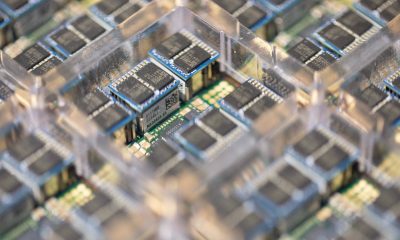
 Elon Musk4 days ago
Elon Musk4 days agoElon Musk subtly confirms one of Tesla AI8’s uses, and it’s literally out of this world
-
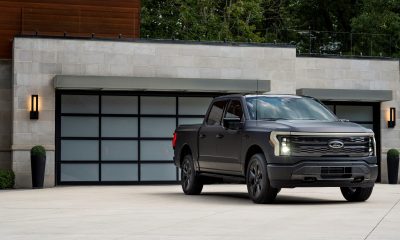
 News12 hours ago
News12 hours agoFord reportedly considers cancelling F-150 Lightning: ‘The demand is just not there’
-
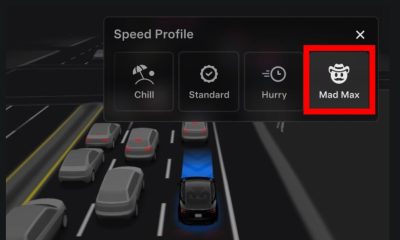
 News2 weeks ago
News2 weeks agoTesla ‘Mad Max’ gets its first bit of regulatory attention
-

 News1 week ago
News1 week agoNeuralink’s first human patient reflects on 21 months with brain implant “Eve”
-
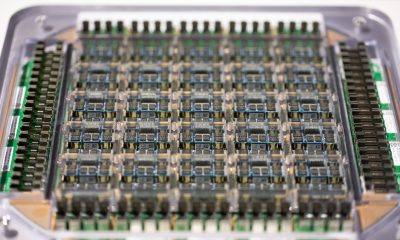
 News2 weeks ago
News2 weeks agoTesla shares AI5 chip’s ambitious production roadmap details
-

 News3 days ago
News3 days agoTesla Cybertruck explosion probe ends with federal involvement and new questions




